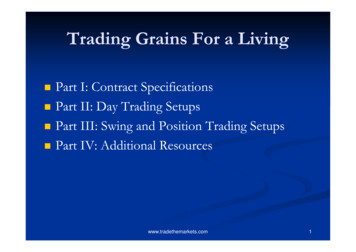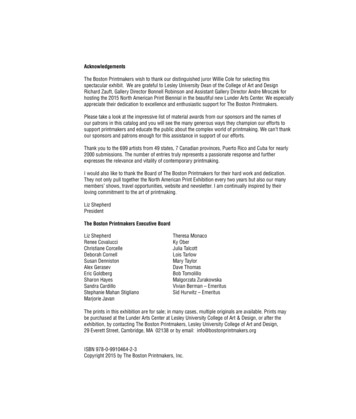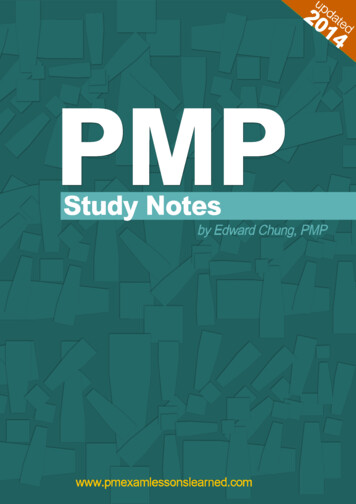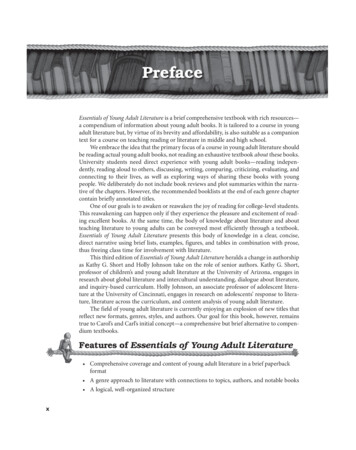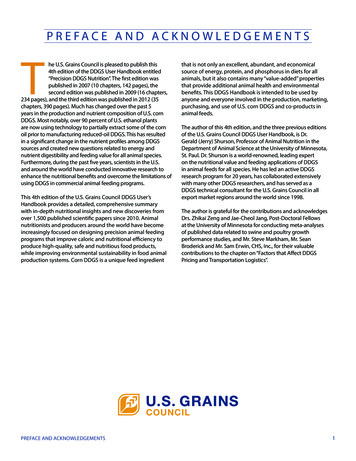
Transcription
P R E FA C E A N D A C K N O W L E D G E M E N T SThe U.S. Grains Council is pleased to publish this4th edition of the DDGS User Handbook entitled“Precision DDGS Nutrition”. The first edition waspublished in 2007 (10 chapters, 142 pages), thesecond edition was published in 2009 (16 chapters,234 pages), and the third edition was published in 2012 (35chapters, 390 pages). Much has changed over the past 5years in the production and nutrient composition of U.S. cornDDGS. Most notably, over 90 percent of U.S. ethanol plantsare now using technology to partially extract some of the cornoil prior to manufacturing reduced-oil DDGS. This has resultedin a significant change in the nutrient profiles among DDGSsources and created new questions related to energy andnutrient digestibility and feeding value for all animal species.Furthermore, during the past five years, scientists in the U.S.and around the world have conducted innovative research toenhance the nutritional benefits and overcome the limitations ofusing DDGS in commercial animal feeding programs.This 4th edition of the U.S. Grains Council DDGS User’sHandbook provides a detailed, comprehensive summarywith in-depth nutritional insights and new discoveries fromover 1,500 published scientific papers since 2010. Animalnutritionists and producers around the world have becomeincreasingly focused on designing precision animal feedingprograms that improve caloric and nutritional efficiency toproduce high-quality, safe and nutritious food products,while improving environmental sustainability in food animalproduction systems. Corn DDGS is a unique feed ingredientPREFACE AND ACKNOWLEDGEMENTSthat is not only an excellent, abundant, and economicalsource of energy, protein, and phosphorus in diets for allanimals, but it also contains many “value-added” propertiesthat provide additional animal health and environmentalbenefits. This DDGS Handbook is intended to be used byanyone and everyone involved in the production, marketing,purchasing, and use of U.S. corn DDGS and co-products inanimal feeds.The author of this 4th edition, and the three previous editionsof the U.S. Grains Council DDGS User Handbook, is Dr.Gerald (Jerry) Shurson, Professor of Animal Nutrition in theDepartment of Animal Science at the University of Minnesota,St. Paul. Dr. Shurson is a world-renowned, leading experton the nutritional value and feeding applications of DDGSin animal feeds for all species. He has led an active DDGSresearch program for 20 years, has collaborated extensivelywith many other DDGS researchers, and has served as aDDGS technical consultant for the U.S. Grains Council in allexport market regions around the world since 1998.The author is grateful for the contributions and acknowledgesDrs. Zhikai Zeng and Jae-Cheol Jang, Post-Doctoral Fellowsat the University of Minnesota for conducting meta-analysesof published data related to swine and poultry growthperformance studies, and Mr. Steve Markham, Mr. SeanBroderick and Mr. Sam Erwin, CHS, Inc., for their valuablecontributions to the chapter on “Factors that Affect DDGSPricing and Transportation Logistics”.1
TA B L E O F C O N T E N T SP R E FA C E A N D A C K N O W L E D G E M E N T SC H A P T E R 1 . . . . . . . . . . . The Role of U.S. DDGS in Precision Animal Nutrition and Feeding the World SustainablyC H A P T E R 2 . . . . . . . . . . . The “Disconnect” Between DDGS Price and Economic ValueC H A P T E R 3 . . . . . . . . . . . Dry-Grind Production of Ethanol, Distillers Corn Oil, and Corn Co-ProductsC H A P T E R 4 . . . . . . . . . . . Chemical Composition and Energy Value of Distillers Corn Oil for Swine and PoultryC H A P T E R 5 . . . . . . . . . . . Emerging Technologies in Ethanol Production and Nutritional Composition of theHigh Protein Corn Co-Products ProducedC H A P T E R 6 . . . . . . . . . . . Nutrient Composition and Variability of Reduced-Oil Corn DDGS SourcesC H A P T E R 7 . . . . . . . . . . . Recommended Laboratory Analytical Procedures for DDGSC H A P T E R 8 . . . . . . . . . . . Comparison of Nutrition and Quality Differences Between China vs. U.S. DDGS SourcesC H A P T E R 9 . . . . . . . . . . . Physical and Chemical Characteristics Related to Handling and Storage of DDGSC H A P T E R 1 0 . . . . . . . . . . DDGS Color IS NOT a Reliable Indicator of DDGS Quality and Nutritional ValueC H A P T E R 1 1 . . . . . . . . . . Feed Safety of DDGSC H A P T E R 1 2 . . . . . . . . . . Benefits and Concerns of Sulfur in DDGSC H A P T E R 1 3 . . . . . . . . . . Reduced-Oil DDGS in Aquaculture DietsC H A P T E R 1 4 . . . . . . . . . . Extruding Aquaculture Diets Containing DDGSC H A P T E R 1 5 . . . . . . . . . . Reduced-Oil DDGS in Beef Cattle DietsC H A P T E R 1 6 . . . . . . . . . . Enscherichia coli 0157:H7 and Listeria monocytogenes Shedding in Beef and Dairy CattleC H A P T E R 1 7 . . . . . . . . . . Reduced-Oil DDGS in Dairy Cattle DietsC H A P T E R 1 8 . . . . . . . . . . Reduced-Oil DDGS in Broiler and Layer DietsC H A P T E R 1 9 . . . . . . . . . . Pelleting DDGS Diets for PoultryC H A P T E R 2 0 . . . . . . . . . . DDGS in Duck and Geese DietsC H A P T E R 2 1 . . . . . . . . . . Reduced-Oil DDGS in Swine DietsC H A P T E R 2 2 . . . . . . . . . . Pelleting DDGS Diets for SwineC H A P T E R 2 3 . . . . . . . . . . Use of Enzymes in DDGS Diets for Poultry and SwineC H A P T E R 2 4 . . . . . . . . . . DDGS in Sheep and Goat DietsC H A P T E R 2 5 . . . . . . . . . . DDGS in Horse, Rabbit, and Dog DietsC H A P T E R 2 6 . . . . . . . . . . Impact of Diet Formulation Methods on Assessing Value of DDGSC H A P T E R 2 7 . . . . . . . . . . The Role of DDGS in Environmental SustainabilityC H A P T E R 2 8 . . . . . . . . . . Factors that Affect DDGS Pricing and Transportation LogisticsC H A P T E R 2 9 . . . . . . . . . . Summary of U.S. Grains Council Sponsored International Reduced-Oil DDGS Feeding TrialsC H A P T E R 3 0 . . . . . . . . . Frequently Asked Questions about DDGSC H A P T E R 3 1 . . . . . . . . . . U.S. Suppliers of DDGSC H A P T E R 3 2 . . . . . . . . . . Glossary of TermsC H A P T E R 3 3 . . . . . . . . . . Website LinksC H A P T E R 3 4 . . . . . . . . . . Key Review Articles and Additional ReadingTABLE OF CONTENTS2
CHAPTER 1The Role of U.S. DDGS in Precision Animal Nutritionand Feeding the World SustainablyWE LIVE IN A WORLD OF TREMENDOUS CHALLENGES. Perhapsone of the greatest of these challenges is to develop andimplement new approaches and technologies to providea growing global population of people with an adequatesupply of nutritious, safe, affordable food while preservingnatural resources and minimizing negative environmentalimpacts. The global demand for food is projected to increaseby 60 percent by 2050, which will increase demand formeat, milk and eggs from the increasing global middleclass of consumers (Alexandratos and Bruinsma, 2012).Fortunately, food animal production is expected to increaseand represent 50 percent of global agricultural output valuewithin the next 10 years (FAO, 2008). However, to meetthis demand, everyone involved in the food productionchain must develop and implement new technologies toincrease the amount and efficiency of food produced.Many structural changes and new animal nutritional andproduction innovations have been developed and are beingimplemented in food animal production systems aroundthe world. New “precision animal nutrition” innovations areincreasing at an accelerating pace to meet the challengesof providing food security, food safety and environmentalsustainability. The goal of “precision animal nutrition” is toimprove the caloric and nutritional efficiency of convertingenergy and nutrients present in feed ingredients into highquality, animal-derived food products.The global feed industry plays a significant role in feeding theworld sustainably. Nearly 1 billion tons of global annual feedproduction occurs in over 130 countries around the world(IFIF, 2016). While various feed grains such as corn, sorghum,wheat and barley represent major ingredients used in animalfeeds, the vast majority of feed ingredients used by the globalfeed industry are by-products derived from various agriculturaland food industries that are unfit for human consumption,but provide valuable energy and essential nutrients in animalfeeds. Therefore, the feed industry plays a vital role in“recycling” nutrients, capturing economic value, improvingfood security and minimizing negative environmental impactsby using these nutrient sources to produce abundant amountsof high quality animal-derived foods.One of the controversial topics associated with the ability ofglobal agriculture to feed the world sustainably is the “food vs.fuel debate”. This controversy involves the tradeoffs of usinga portion of the grains and oilseeds produced for biofuels,rather than using this portion for animal feed and human food.However, only 6 percent of total global grain production isused to produce ethanol (Popp et al., 2016), and about 33percent of the corn used to produce ethanol in the dry-grindethanol industry is recovered as co-products for use in animalfeeds. Therefore, although the demand for corn to produceethanol has increased, all of the non-starch components arerecovered and concentrated (by about three fold) in the coproducts compared with concentrations of these nutrients incorn grain, and are being used to displace significant amountsof corn and soybean meal in animal feeds.The global biofuels industry produces about 52 million tonsof co-products for use in animal feed, and about 85 percentof these co-products are produced by the ethanol industry(Popp et al., 2016). The United States ethanol industry is thelargest producer of corn co-products, with annual productionof about 38 million tons. This amount of corn co-productproduction is comparable to the amount of soybean mealproduced in the U.S. annually, and is being used in largequantities in animal feeds both domestically, as well as inover 30 countries around the world. In addition, DDGS hasbeen the most extensively researched feed ingredient amongall major feed ingredients used in the global feed industryin the past 20 years. Research has not only focused onimproving caloric and nutritional efficiency, and identifyingCHAPTER 1 The Role of U.S. DDGS in Precision Animal Nutrition and Feeding the World Sustainably3
benefits and limitations for optimal DDGS use in all animalfeeds, but research efforts are becoming increasinglyfocused on characterizing the unique nutraceutical propertiesand environmental impacts of DDGS.The high-energy, protein and phosphorus content of DDGSmake it a very attractive partial replacement for some of themore expensive traditional energy (corn), protein (soybeanmeal) and phosphorus (mono- or dicalcium phosphate)ingredients used in animal feeds. When DDGS is addedto animal feeds that are properly formulated, it providesexcellent animal performance, health and food productquality. These attributes, and others, have made DDGS oneof the most popular feed ingredients to use in animal feedsaround the world.Due to the large supply of U.S. DDGS currently beingproduced, the quantity available for export has continued toincrease. Much of this increased demand is a direct result ofend-users capturing significant diet cost savings compared toother competing ingredients available. However, even thoughU.S. DDGS has been used in animal feeds domestically formany decades, it is a relatively unfamiliar feed ingredient formany nutritionists, feed manufacturers and animal producersaround the world. As with any new feed ingredient in theglobal market, there are many technical questions about thenutritional benefits, limitations and use of DDGS in animal feedsto capture the greatest economic value. Even for experiencedend-users, the production of reduced-oil (seven to nine percentcrude fat) DDGS has led to many questions about energycontent and feeding value compared to traditional high-oil(greater than 10 percent crude fat) for various animal species.This 4th revised edition of the U.S. Grains Council DDGS UserHandbook – Precision DDGS Nutrition, was written to providenutritionists, feed ingredient purchasers, feed manufacturersand animal producers with the most up to date, scientificallybased information available related to developing precisionnutrition animal feeding programs using DDGS.The U.S. Grains Council (USGC) provides this comprehensivesummary of nutritional information about DDGS to assistcurrent and potential buyers in understanding its nutritionalcharacteristics, recommended maximum dietary inclusionrates, and benefits and limitations for its use in animalfeeds. As for any feed ingredient, end-users of DDGSshould consult, and seek assistance and advice from aqualified nutritionist when formulating diets and developingfeeding recommendations. The USGC has no controlover the nutritional content of any specific ingredientselected for feeding. The USGC makes no warranties theserecommendations are suitable for any particular herd, flock,or animal. The USGC disclaims any liability for itself or itsmembers for any problems encountered in the use of theserecommendations. By reviewing this material, buyers agreeto these limitations and waive any claims against USGC forliability arising out of this information.For more information, contact the U.S. Grains Councilat 202-789-0789 or email grains@grains.org. Also visitwww.grains.org.ReferencesAlexandratos, N., and J. Bruinsma. 2012. World agriculturetowards 2030/2050: The 2012 revision. ESA WorkingPaper No. 12-03, June, Agriculture DevelopmentEconomic Division, Food and Agricultural Organization ofthe United Nations (FAO), Rome, Italy.Food and Agricultural Organization of the United Nations(FAO). 2008. The Global Livestock Sector – A GrowthEngine, Rome, Italy dfInternational Feed Industry Federation. 2016. The GlobalFeed Industry. Wie
03.11.2011 · Handbook – Precision DDGS Nutrition, was written to provide nutritionists, feed ingredient purchasers, feed manufacturers and animal producers with the most up to date, scienti cally based information available related to developing precision nutrition animal feeding programs using DDGS. The U.S. Grains Council (USGC) provides this comprehensive
